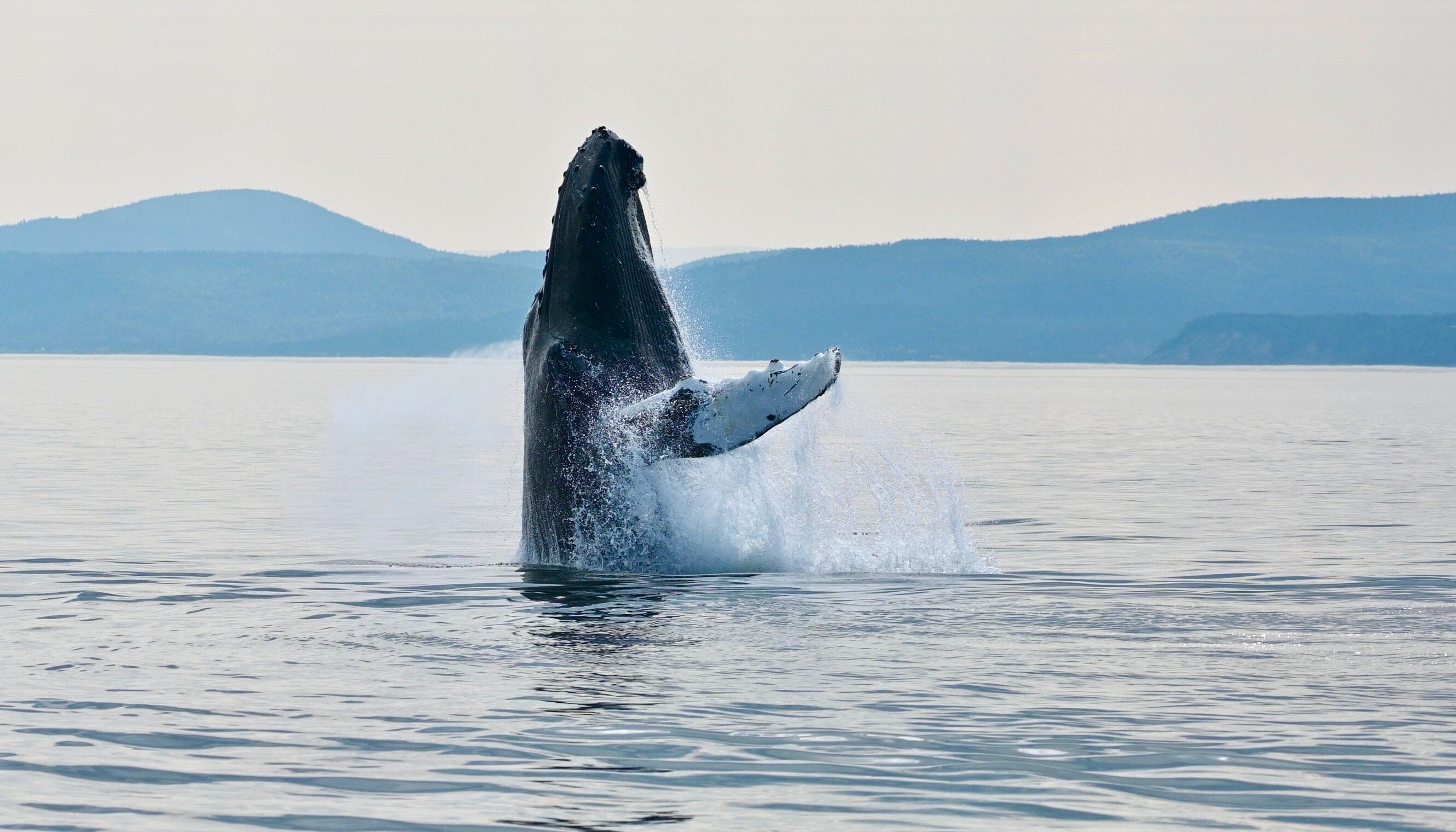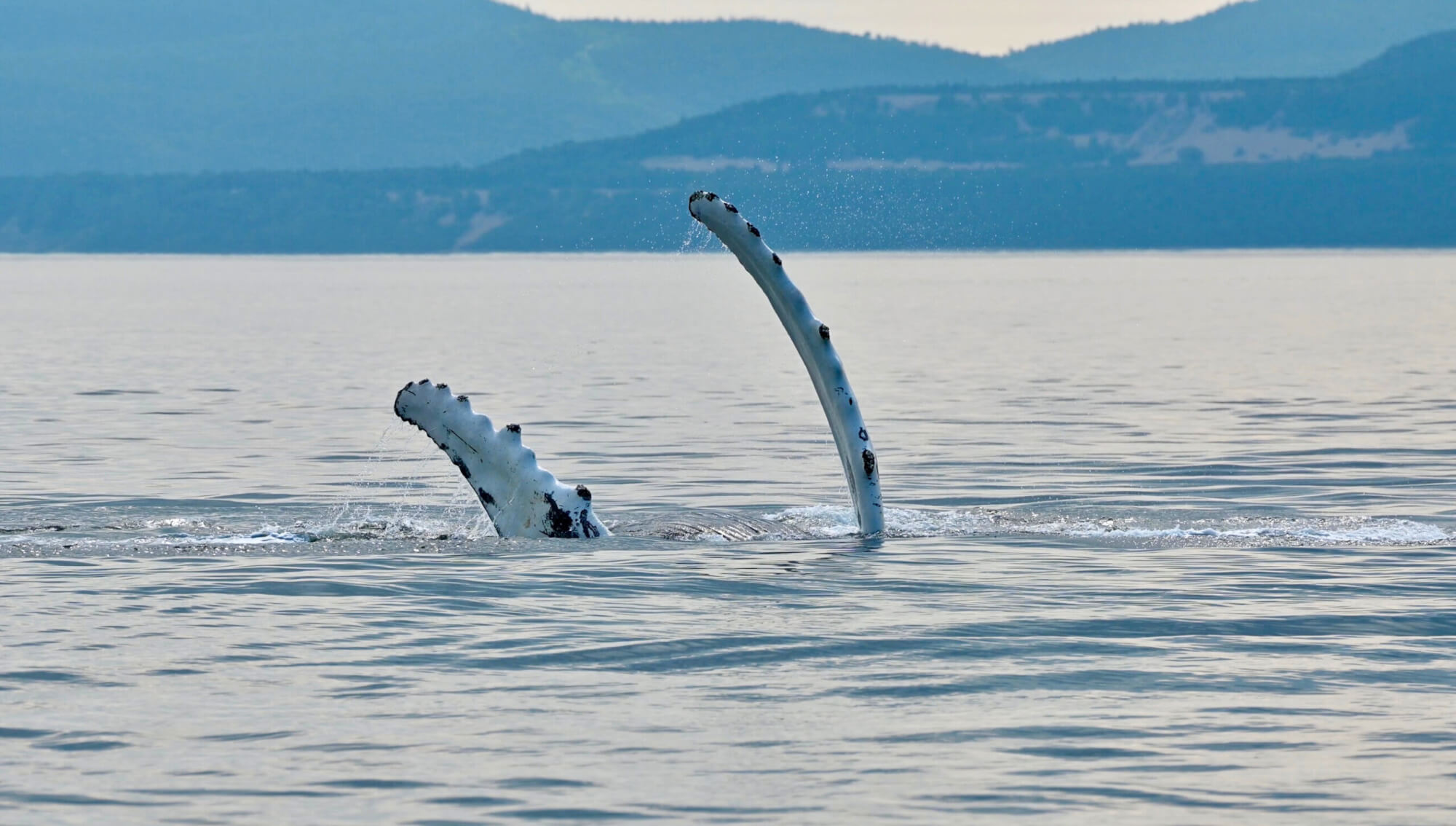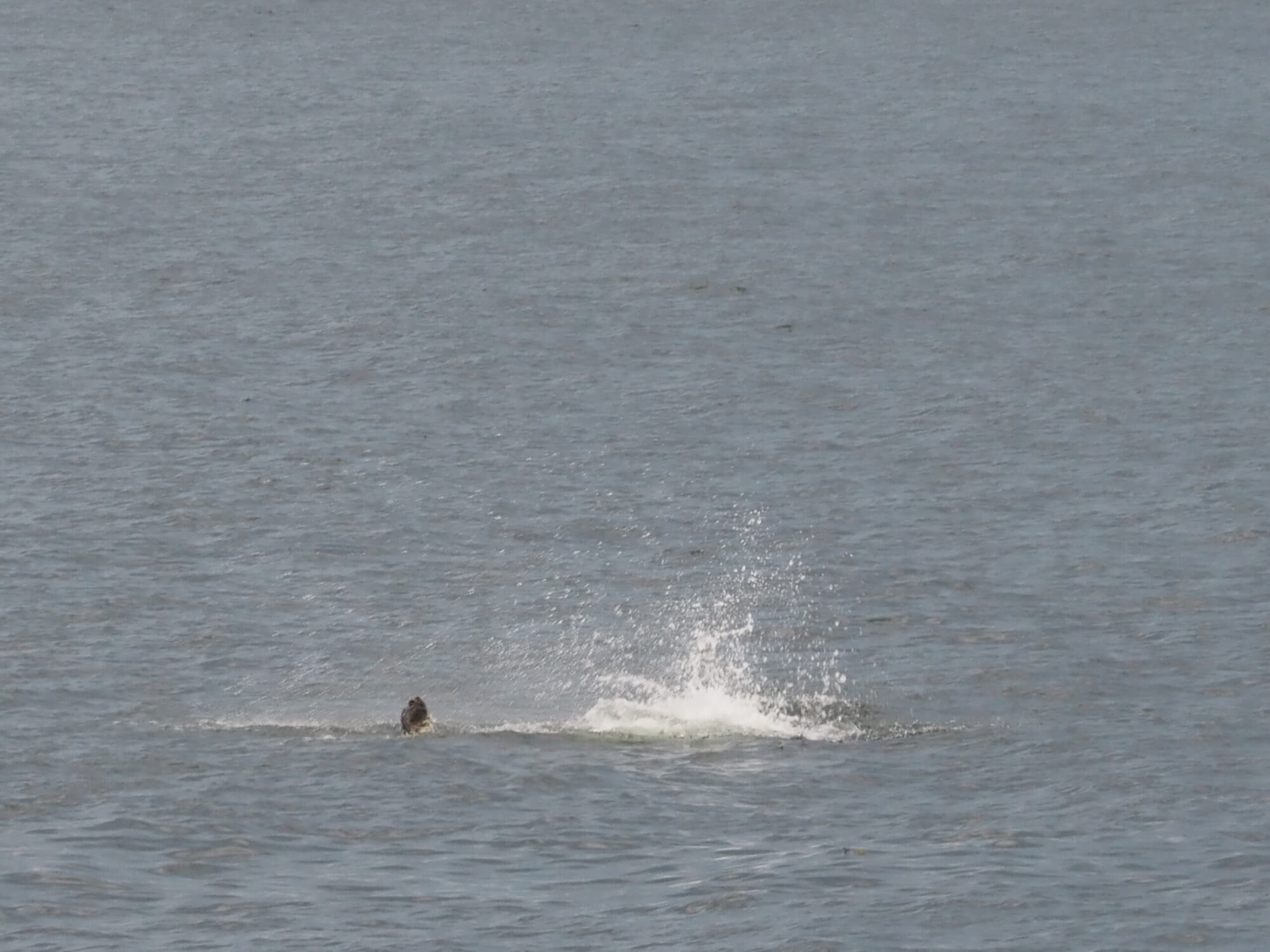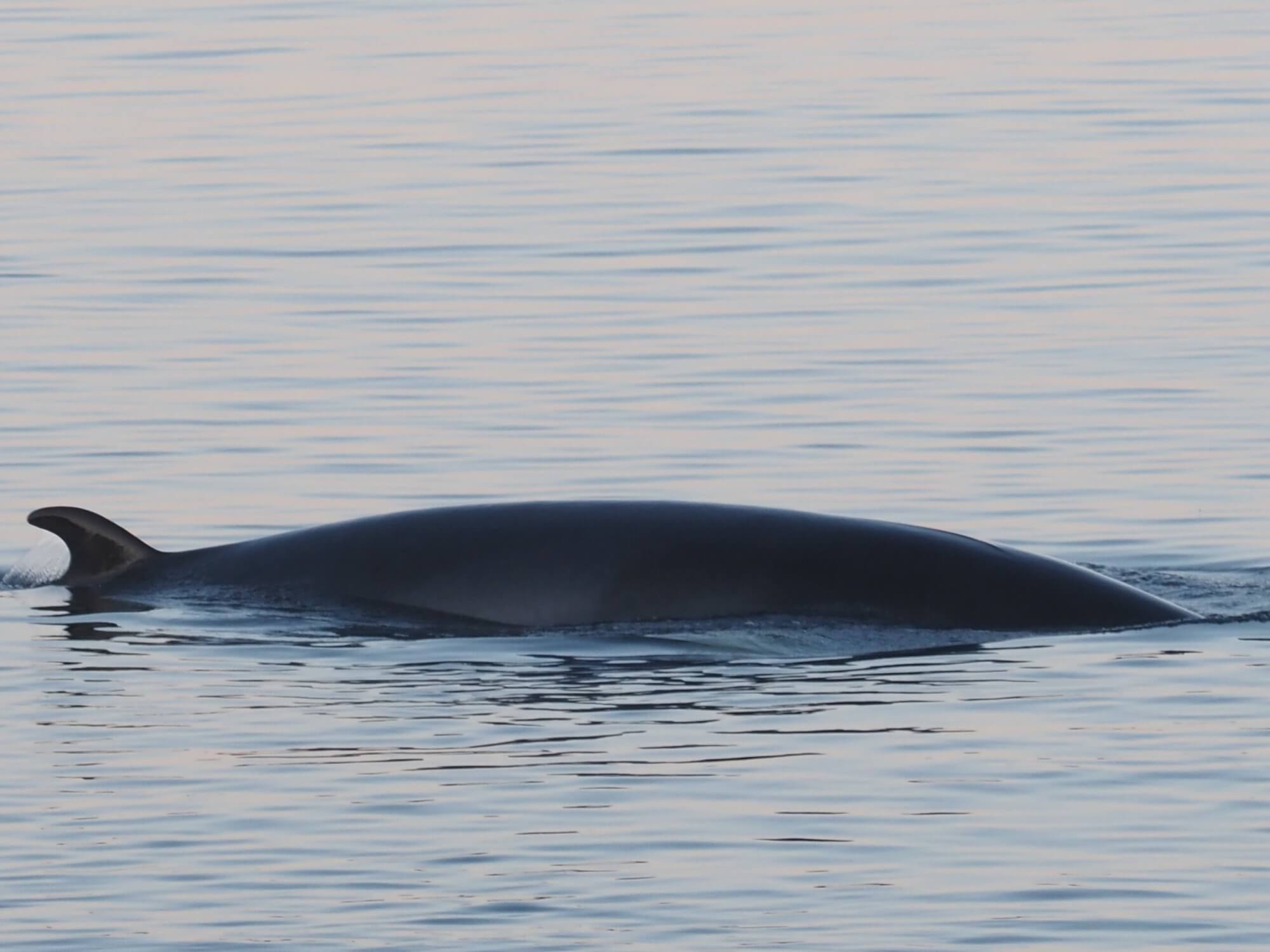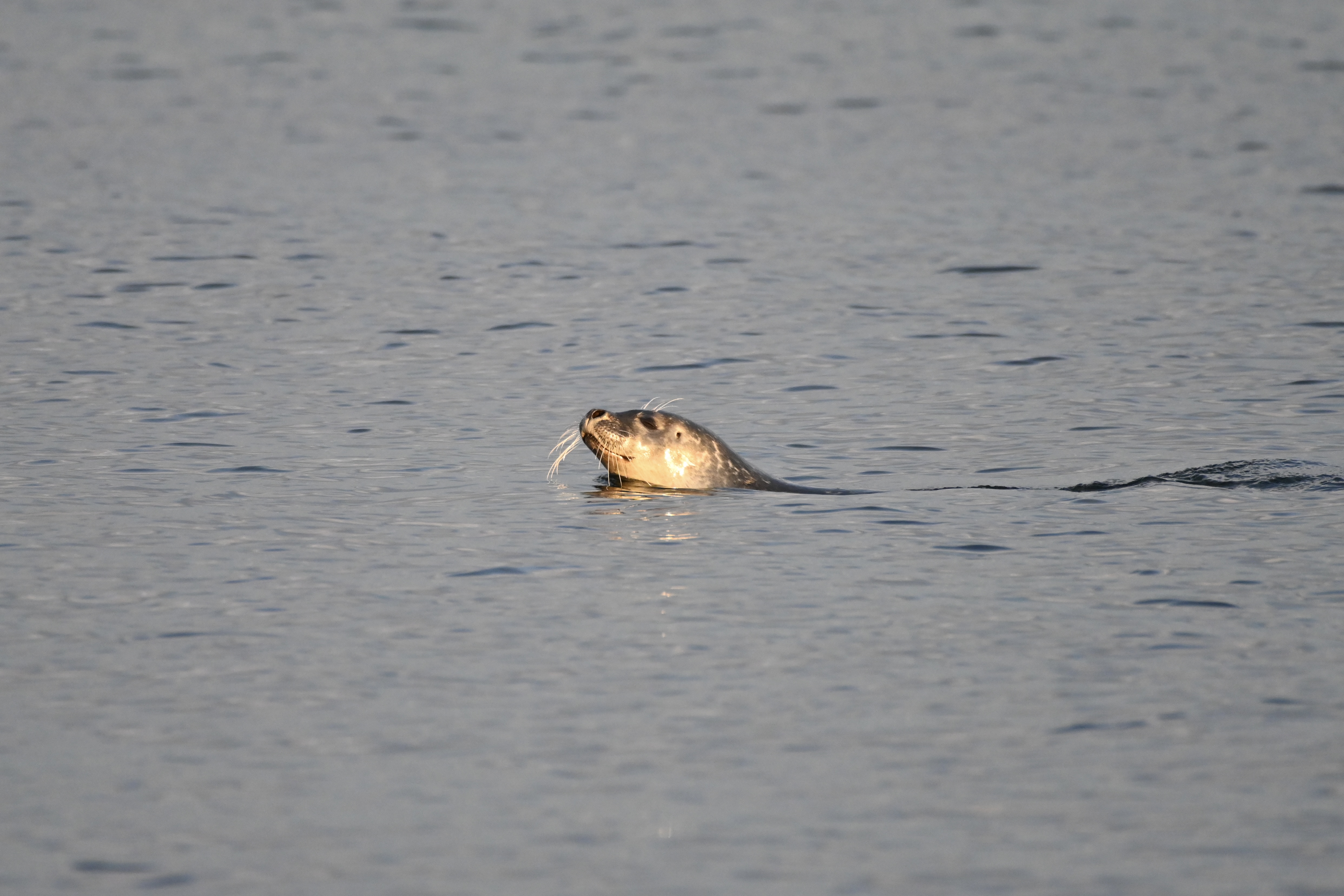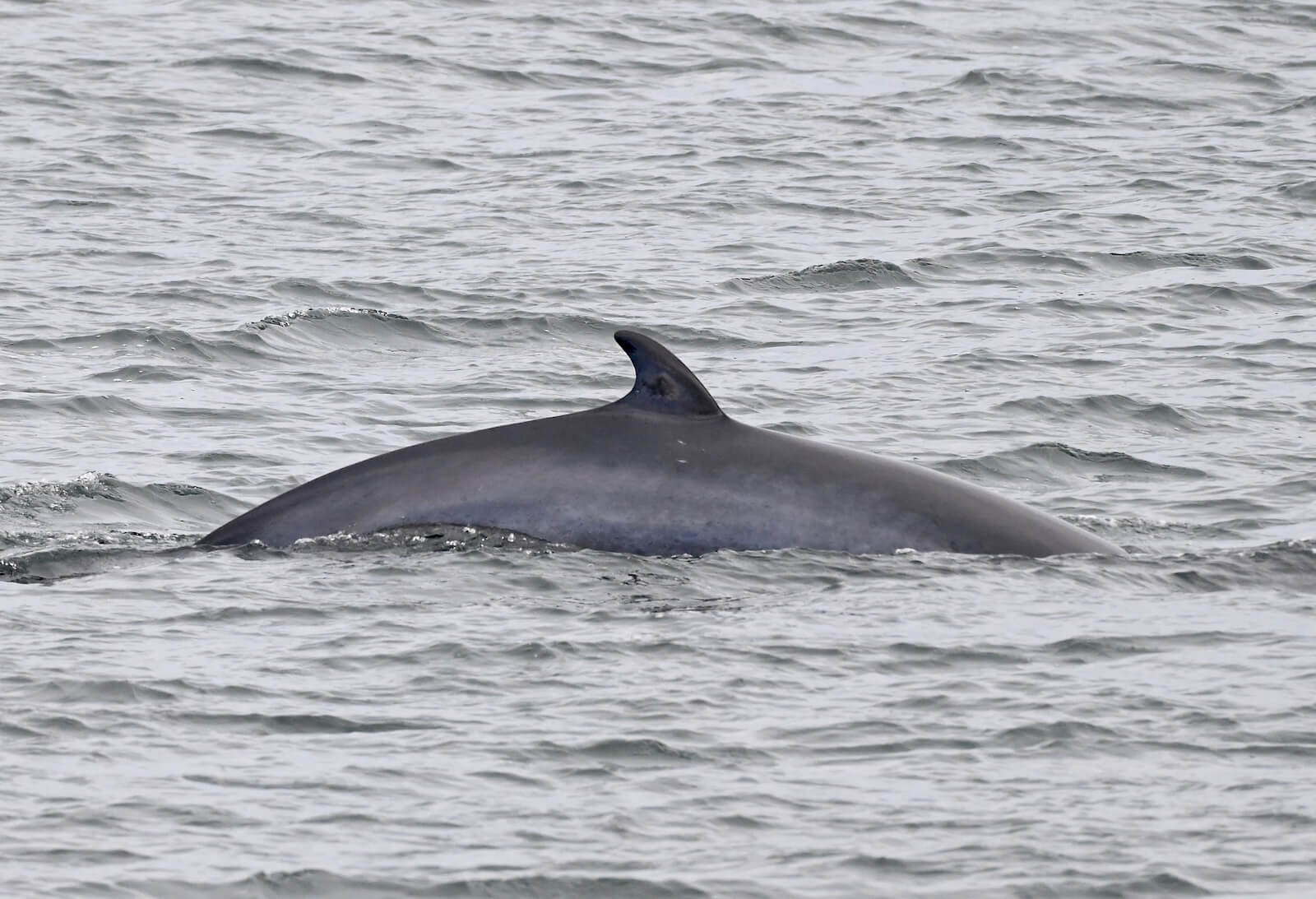Whether it’s a blue whale swimming off the coast of Matane, fin whales in Gaspé Bay, North Atlantic right whales near Mingan, humpbacks wowing spectators in the estuary or minke whales feeding in the waters of the Baie-Comeau marina, the recent scorching days of summer have been replete with cetaceans! From the tips of their tails to the end of their rostrum, these animals never cease to amaze with their immensity and mysterious behaviours.
Exciting visit to Port-au-Persil
A resident of Port-au-Persil has had more than his fair share of marine mammals over the past week! From his clifftop property, he enjoys a stunning view of the river. He rattles off the marine fauna that he saw roaming in front of his house: “Besides a group of five seals, two separate herds of belugas each comprising two or three bleuvets, and a few minke whales, there were notably two humpbacks, the smaller of which seems to me to be Katana (H944). They remained in the area for nearly two hours, just a few metres from shore. The smaller of the two, H944, breached three times and the other individual just once.” After analyzing the photos, GREMM confirmed that it was indeed the humpback whale Katana, who was first observed in the estuary in 2018.
Port-au-Persil has definitely been attracting marine mammals like a magnet lately! One observer also mentions the presence of humpbacks, in addition to seals, belugas, porpoises, minke whales, and a single fin whale. She dreams as she imagines what might come next… perhaps a blue whale will pass through?
Active belugas
In Baie-Saint-Marguerite, numerous belugas were observed from the lookout that stands two kilometres from the discovery and visitors centre of the Fjord-du-Saguenay National Park. On July 28, a naturalist mentions the presence of a group of 30 to 40 individuals, including several juveniles. Pectorals, tails, spy hopping, surface slapping, and even strange noises… There was certainly plenty of action! Within their groups, belugas can be highly dynamic. These behaviours can be related to feeding, playing between juveniles or even sexual behaviours.
Rorquals on full display
When she boarded her whale-watching boat, one cetacean enthusiast had no idea what was in store for her! “All of a sudden, we heard a big blow,” she recalls. “We had just crossed paths with Piton! Impressive in size, it did us the honour of feeding next to us and showing us its tail!” Piton is one of the most faithful fin whales in the estuary. It can be recognized by the small protuberance on its left chevron as well as by its highly contrasting chevrons.
A little later, another blast rang out: “No doubt about it, it’s a humpback. And not just any one: It was Éline, whom we immediately recognized when she dove next to us and showed the colour pattern of her tail. And while we were waiting for her to breathe again at the surface, she put on a completely different show! Éline was feeding right next to us! An incredible spectacle that will forever remain etched in my memory!”
Near the town of Les Bergeronnes, the humpback Gaspar also put on a memorable display for one naturalist. After a series of breaches, the whale started making a ruckus with its pectorals: “It began to strike the surface of the water with its fins,” he shares.” The animal continued in this manner before finally taking another dive. “And as Murphy’s law says: What can happen will happen. The whale hurls itself into the air […].” Following these observations, he now prefers Gaspar’s other name: Boom Boom River (BBR), which is the moniker originally given to the animal in the Gaspé and Mingan Archipelago regions. This nickname is a reference to the municipality of Rivière-au-Tonnerre (locally called “BBR”), where MICS apparently first observed this individual in 2005, the year she was born. However, it’s for a different reason that the naturalist has a change of heart: “Now I’m using the animal’s original name: Boom Boom River. After all, she’s the one making the most “boom boom” this summer!”
A Whales Online subscriber was spending her holiday in a chalet in Les Escoumins. She takes the opportunity to share her observations with us: “We were particularly lucky this week with three humpbacks coming and going in front of the chalet. On Sunday, two fin whales joined the parade. Tuesday afternoon was the most active period, with humpbacks, fin whales, porpoises (some breaching), belugas (a few showing their tails), plus minke whales and seals skirting the coast. What an idyllic place to spend one’s vacation!
Euphoria on the coast
“The waters are peppered with minke whales and porpoises,” comments a Côte-Nord resident, speaking of the sector between Baie-Comeau and Franquelin. The Baie-Comeau marina area seems to be a choice feeding area for minke whales, which continue to come and hunt amongst the seals and gannets.
Harbour porpoises have also been brightening up the waters as far downstream as Pointe-des-Monts, where more than 40 individuals were seen at once. “It was hard to get a good count,” explains a local resident, “they were everywhere!” The white backs of belugas continue to be observed in groups of four or five on a nearly daily basis. On a day with strong southwesterly winds stirring up the water, a minke whale was seen breaching.
The Mingan Island Cetacean Study team has also been racking up some impressive sightings: five fin whales, two North Atlantic right whales, a blue whale and a humpback. A large animal that is not a mammal also makes it onto the sightings list: two basking sharks!
On the other side of the river, a blue whale was seen off Matane. Could it be the same individual that was lingering off Cap-des-Rosiers for several days? “Fin whales have been present in Gaspé Bay,” explains a regular. “And the minke whales are back with a vengeance, breaching and surface feeding at Cap Gaspé.”
Where are the whales this week? Observation map
These data were reported by our network of observers. They give an idea of the presence of whales and in no way represent the actual distribution of whales in the St. Lawrence. Just for fun!
Click on the whale or seal icons to discover the species, the number of individuals, additional information or photos of the sighting. To enlarge the map, click on the icon in the top right-hand corner. The map works well on Chrome and Firefox, but not so well on Safari.
To display the list of sightings, click on the icon in the top left-hand corner.
Thanks to all our collaborators!
Special thanks go out to all our observers who share their love for marine mammals with us! Your encounters with cetaceans and pinnipeds are always a pleasure to read and discover.
On the water or from shore, it is your eyes that give life to this column.
Odélie Brouillette
Marie-Andrée Charleboix
Clara Comeau
Thalia Cohen-Bacry
Laetitia Desbordes
Louis-Pierre Ducharme-Tremblay
Pierre-Soleil Dion
Céline Labrie
Louise Lapierre
Yael Medav
Diane Ostiguy
Chloé Pazart
Delphine Plassart
Renaud Pintiaux
Pascal Pitre
Jean Roy
René Roy
Guillaume Savard
Christine Stadelmann
Andréanne Sylvain
Marielle Vanasse
Additionally, we would like to acknowledge the following teams that also share their sightings:
Sept-Îles Research and Education Centre (CERSI)
Group for Research and Education on Marine Mammals (GREMM)
Marine Mammal Observation Network (MMON)
Quebec Marine Mammal Emergency Response Network (QMMERN)
Mingan Island Cetacean Study (MICS)
Would you also like to share your observations?
Have you seen any marine mammals in the St. Lawrence? Whether it’s a spout offshore or just a couple of seals, drop us a line and send your photos to [email protected]!


